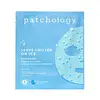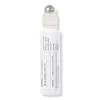What's inside
What's inside
 Key Ingredients
Key Ingredients

 Benefits
Benefits

 Concerns
Concerns

 Ingredients Side-by-side
Ingredients Side-by-side

Rubus Chamaemorus Fruit Extract
AntioxidantBakuchiol
AntimicrobialAvena Sativa Peptide
Skin ConditioningWater
Skin ConditioningGlycerin
HumectantDipropylene Glycol
HumectantCeratonia Siliqua Gum
EmollientErythritol
HumectantChondrus Crispus Powder
Abrasive1,2-Hexanediol
Skin ConditioningChondrus Crispus Extract
Skin ConditioningButylene Glycol
HumectantCellulose Gum
Emulsion StabilisingPaeonia Suffruticosa Root Extract
Skin ProtectingCentella Asiatica Extract
CleansingAlgin
MaskingChamomilla Recutita Flower Extract
MaskingPotassium Chloride
Glyceryl Caprylate
EmollientDextrin
AbsorbentSucrose
HumectantPolysorbate 20
EmulsifyingCI 77891
Cosmetic ColorantEthylhexylglycerin
Skin ConditioningSodium Hyaluronate
HumectantGardenia Florida Fruit Extract
Skin ConditioningPolymethylsilsesquioxane
Methyl Diisopropyl Propionamide
MaskingSilica
AbrasiveMenthyl Lactate
MaskingUrea
BufferingYeast Amino Acids
HumectantBetaine
HumectantInositol
HumectantTaurine
BufferingTrehalose
HumectantPolyglyceryl-10 Laurate
Skin ConditioningPotassium Sorbate
PreservativeTripeptide-1
Skin ConditioningAcetyl Tetrapeptide-2
Skin ConditioningAcetyl Tetrapeptide-5
HumectantCopper Tripeptide-1
Skin ConditioningPalmitoyl Tripeptide-1
Skin ConditioningPalmitoyl Pentapeptide-4
Skin ConditioningHexapeptide-11
Skin ConditioningHexapeptide-9
Skin ConditioningPalmitoyl Tripeptide-5
Skin ConditioningDisodium EDTA
Phenoxyethanol
PreservativeParfum
MaskingLimonene
PerfumingAlpha-Isomethyl Ionone
PerfumingCI 77007
Cosmetic ColorantRubus Chamaemorus Fruit Extract, Bakuchiol, Avena Sativa Peptide, Water, Glycerin, Dipropylene Glycol, Ceratonia Siliqua Gum, Erythritol, Chondrus Crispus Powder, 1,2-Hexanediol, Chondrus Crispus Extract, Butylene Glycol, Cellulose Gum, Paeonia Suffruticosa Root Extract, Centella Asiatica Extract, Algin, Chamomilla Recutita Flower Extract, Potassium Chloride, Glyceryl Caprylate, Dextrin, Sucrose, Polysorbate 20, CI 77891, Ethylhexylglycerin, Sodium Hyaluronate, Gardenia Florida Fruit Extract, Polymethylsilsesquioxane, Methyl Diisopropyl Propionamide, Silica, Menthyl Lactate, Urea, Yeast Amino Acids, Betaine, Inositol, Taurine, Trehalose, Polyglyceryl-10 Laurate, Potassium Sorbate, Tripeptide-1, Acetyl Tetrapeptide-2, Acetyl Tetrapeptide-5, Copper Tripeptide-1, Palmitoyl Tripeptide-1, Palmitoyl Pentapeptide-4, Hexapeptide-11, Hexapeptide-9, Palmitoyl Tripeptide-5, Disodium EDTA, Phenoxyethanol, Parfum, Limonene, Alpha-Isomethyl Ionone, CI 77007
Water
Skin ConditioningPropanediol
SolventGlycerin
HumectantPentylene Glycol
Skin ConditioningAlgin
MaskingAlpha-Glucan Oligosaccharide
CleansingAmmonium Acryloyldimethyltaurate/Vp Copolymer
Ascorbic Acid
AntioxidantCI 77120
Cosmetic ColorantBisabolol
MaskingButylene Glycol
HumectantCaffeine
Skin ConditioningCamellia Sinensis Leaf Extract
AntimicrobialCaprylyl Glycol
EmollientCellulose
AbsorbentChamomilla Recutita Flower Extract
MaskingChenopodium Quinoa Seed Extract
Skin ConditioningChlorella Vulgaris Extract
Skin ConditioningCitric Acid
BufferingCoffea Arabica Seed Extract
MaskingCoffea Robusta Seed Extract
Skin ConditioningCrataegus Monogyna Flower Extract
Skin ConditioningCucumis Sativus Fruit Extract
EmollientDisodium Phosphate
BufferingEthylhexylglycerin
Skin ConditioningGlyceryl Acrylate/Acrylic Acid Copolymer
HumectantGlyceryl Polyacrylate
Helianthus Annuus Seed Oil
EmollientHydrolyzed Sodium Hyaluronate
Skin ConditioningHydroxyethylcellulose
Emulsion StabilisingJasminum Sambac Flower Extract
MaskingJojoba Esters
EmollientLactic Acid
BufferingLactobacillus
Skin ConditioningLactobacillus/Arundinaria Gigantea Ferment Filtrate
Skin ConditioningLaminaria Digitata Extract
Skin ProtectingLecithin
EmollientLeuconostoc/Radish Root Ferment Filtrate
AntimicrobialLonicera Caprifolium Flower Extract
PerfumingLonicera Japonica Flower Extract
Skin ConditioningMaltodextrin
AbsorbentMaris Aqua
HumectantMica
Cosmetic ColorantPhenethyl Alcohol
MaskingPolyglyceryl-3 Diisostearate
EmulsifyingPolymnia Sonchifolia Root Juice
Skin ConditioningPotassium Phosphate
BufferingPullulan
Saccharide Isomerate
HumectantSalvia Hispanica Seed Oil
MoisturisingSerine
MaskingSilica
AbrasiveSodium Carboxymethyl Beta-Glucan
CleansingSodium Hyaluronate
HumectantSodium Polyacrylate
AbsorbentTetrasodium Glutamate Diacetate
Titanium Dioxide
Cosmetic ColorantTocopherol
AntioxidantTrehalose
HumectantUrea
BufferingYogurt
Skin ProtectingYogurt Powder
Zingiber Officinale Root Extract
MaskingBenzyl Alcohol
PerfumingPhenoxyethanol
PreservativePotassium Sorbate
PreservativeSodium Benzoate
MaskingWater, Propanediol, Glycerin, Pentylene Glycol, Algin, Alpha-Glucan Oligosaccharide, Ammonium Acryloyldimethyltaurate/Vp Copolymer, Ascorbic Acid, CI 77120, Bisabolol, Butylene Glycol, Caffeine, Camellia Sinensis Leaf Extract, Caprylyl Glycol, Cellulose, Chamomilla Recutita Flower Extract, Chenopodium Quinoa Seed Extract, Chlorella Vulgaris Extract, Citric Acid, Coffea Arabica Seed Extract, Coffea Robusta Seed Extract, Crataegus Monogyna Flower Extract, Cucumis Sativus Fruit Extract, Disodium Phosphate, Ethylhexylglycerin, Glyceryl Acrylate/Acrylic Acid Copolymer, Glyceryl Polyacrylate, Helianthus Annuus Seed Oil, Hydrolyzed Sodium Hyaluronate, Hydroxyethylcellulose, Jasminum Sambac Flower Extract, Jojoba Esters, Lactic Acid, Lactobacillus, Lactobacillus/Arundinaria Gigantea Ferment Filtrate, Laminaria Digitata Extract, Lecithin, Leuconostoc/Radish Root Ferment Filtrate, Lonicera Caprifolium Flower Extract, Lonicera Japonica Flower Extract, Maltodextrin, Maris Aqua, Mica, Phenethyl Alcohol, Polyglyceryl-3 Diisostearate, Polymnia Sonchifolia Root Juice, Potassium Phosphate, Pullulan, Saccharide Isomerate, Salvia Hispanica Seed Oil, Serine, Silica, Sodium Carboxymethyl Beta-Glucan, Sodium Hyaluronate, Sodium Polyacrylate, Tetrasodium Glutamate Diacetate, Titanium Dioxide, Tocopherol, Trehalose, Urea, Yogurt, Yogurt Powder, Zingiber Officinale Root Extract, Benzyl Alcohol, Phenoxyethanol, Potassium Sorbate, Sodium Benzoate
 Reviews
Reviews

Ingredients Explained
These ingredients are found in both products.
Ingredients higher up in an ingredient list are typically present in a larger amount.
Algin is brown algae. Algae is an informal term for a group of aquatic organisms that can photosynthesize. It is estimated there are at least 30,000 types of Algae.
Algae contains antioxidants. Antioxidants help fight free-radicals. Free-radicals are molecules that may damage your skin cells, such as pollution.
Butylene Glycol (or BG) is used within cosmetic products for a few different reasons:
Overall, Butylene Glycol is a safe and well-rounded ingredient that works well with other ingredients.
Though this ingredient works well with most skin types, some people with sensitive skin may experience a reaction such as allergic rashes, closed comedones, or itchiness.
Learn more about Butylene GlycolChamomilla Recutita Flower Extract comes from the Chamomile flower.
Chamomile is rich in antioxidants and has anti-inflammatory properties. Several compounds found in chamomile help with soothing, such as bisbolol.
Antioxidant components in chamomile make it an effective ingredient to help slow the signs of aging. Antioxidants help fight free-radical molecules, or molecules that may damage your skin.
Essential oils from chamomile have been found to improve wound healing due to its antimicrobial properties.
Ancient Greeks and Egyptians used Chamomile to treat skin redness and dryness. Chamomile has also been used to help treat stomach issues.
Learn more about Chamomilla Recutita Flower ExtractEthylhexylglycerin (we can't pronounce this either) is commonly used as a preservative and skin softener. It is derived from glyceryl.
You might see Ethylhexylglycerin often paired with other preservatives such as phenoxyethanol. Ethylhexylglycerin has been found to increase the effectiveness of these other preservatives.
Glycerin is already naturally found in your skin. It helps moisturize and protect your skin.
A study from 2016 found glycerin to be more effective as a humectant than AHAs and hyaluronic acid.
As a humectant, it helps the skin stay hydrated by pulling moisture to your skin. The low molecular weight of glycerin allows it to pull moisture into the deeper layers of your skin.
Hydrated skin improves your skin barrier; Your skin barrier helps protect against irritants and bacteria.
Glycerin has also been found to have antimicrobial and antiviral properties. Due to these properties, glycerin is often used in wound and burn treatments.
In cosmetics, glycerin is usually derived from plants such as soybean or palm. However, it can also be sourced from animals, such as tallow or animal fat.
This ingredient is organic, colorless, odorless, and non-toxic.
Glycerin is the name for this ingredient in American English. British English uses Glycerol/Glycerine.
Learn more about GlycerinPhenoxyethanol is a preservative that has germicide, antimicrobial, and aromatic properties. Studies show that phenoxyethanol can prevent microbial growth. By itself, it has a scent that is similar to that of a rose.
It's often used in formulations along with Caprylyl Glycol to preserve the shelf life of products.
Potassium Sorbate is a preservative used to prevent yeast and mold in products. It is commonly found in both cosmetic and food products.
This ingredient comes from potassium salt derived from sorbic acid. Sorbic acid is a natural antibiotic and effective against fungus.
Both potassium sorbate and sorbic acid can be found in baked goods, cheeses, dried meats, dried fruit, ice cream, pickles, wine, yogurt, and more.
You'll often find this ingredient used with other preservatives.
Learn more about Potassium SorbateSilica, also known as silicon dioxide, is a naturally occurring mineral. It is used as a fine, spherical, and porous powder in cosmetics.
Though it has exfoliant properties, the function of silica varies depending on the product.
The unique structure of silica enhances the spreadability and adds smoothness, making it a great texture enhancer.
It is also used as an active carrier, emulsifier, and mattifier due to its ability to absorb excess oil.
In some products, tiny microneedles called spicules are made from silica or hydrolyzed sponge. When you rub them in, they lightly polish away dead skin layers and enhance the penetration of active ingredients.
Learn more about SilicaSodium Hyaluronate is hyaluronic acid's salt form. It is commonly derived from the sodium salt of hyaluronic acid.
Like hyaluronic acid, it is great at holding water and acts as a humectant. This makes it a great skin hydrating ingredient.
Sodium Hyaluronate is naturally occurring in our bodies and is mostly found in eye fluid and joints.
These are some other common types of Hyaluronic Acid:
Learn more about Sodium HyaluronateTrehalose is a disaccharide made of two glucose molecules (glucose is sugar!). Trehalose is used to help moisturize skin. It also has antioxidant properties.
As a humectant, trehalose helps draw moisture from the air to your skin. This helps keep your skin hydrated.
Due to its antioxidant properties, trehalose may help with signs of aging. Antioxidants help fight free-radical molecules, unstable molecules that may damage your skin.
In medicine, trehalose and hyaluronic acid are used to help treat dry eyes.
Some animals, plants, and bacteria create trehalose as a source of energy to survive freeze or lack of water.
Learn more about TrehaloseUrea is also called carbamide and is the diamide of carbonic acid. In cosmetics, urea is used to hydrate the skin. It also provides exfoliation in higher concentrations.
As a humectant, urea helps draw moisture from the air and from deep within the skin. This helps hydrate your skin. Studies show urea is an effective moisturizer for dry skin conditions. 40% urea is typical in medications for treating eczema and other skin conditions.
Urea has the strongest exfoliation effect in concentrations higher than 10%. It is a keratolytic agent, meaning it breaks down the keratin protein in the top layer of skin. This helps remove dead skin cells and flaking skin.
In medicine, urea has been shown to help increase the potency of other ingredients, such as fungal treatments.
Humans and animals use urea to metabolize nitrogen-containing compounds. Urea is highly soluble in water. Once dissolved, it is neither acidic nor alkaline.
Learn more about UreaWater. It's the most common cosmetic ingredient of all. You'll usually see it at the top of ingredient lists, meaning that it makes up the largest part of the product.
So why is it so popular? Water most often acts as a solvent - this means that it helps dissolve other ingredients into the formulation.
You'll also recognize water as that liquid we all need to stay alive. If you see this, drink a glass of water. Stay hydrated!
Learn more about Water